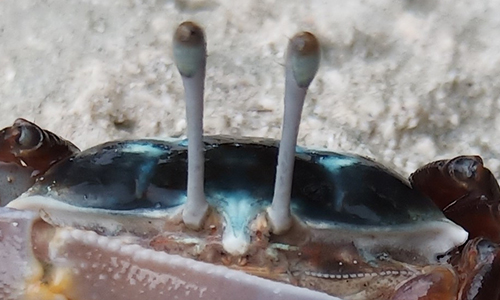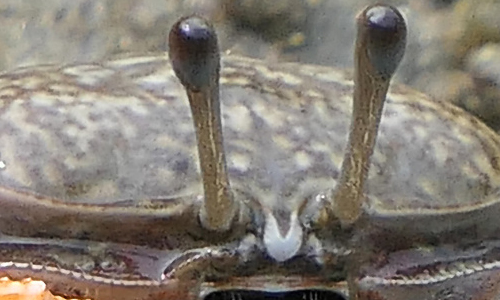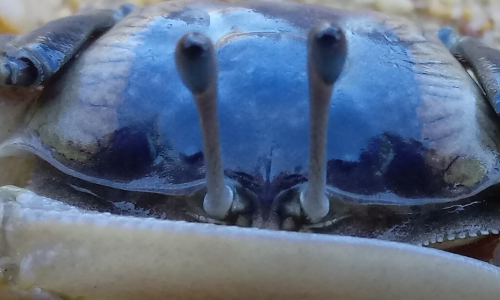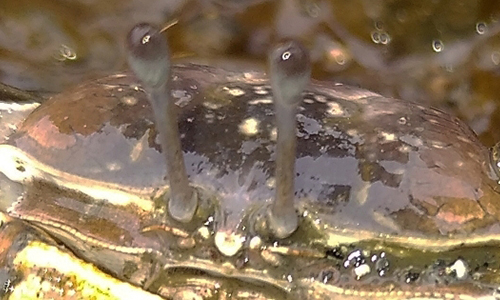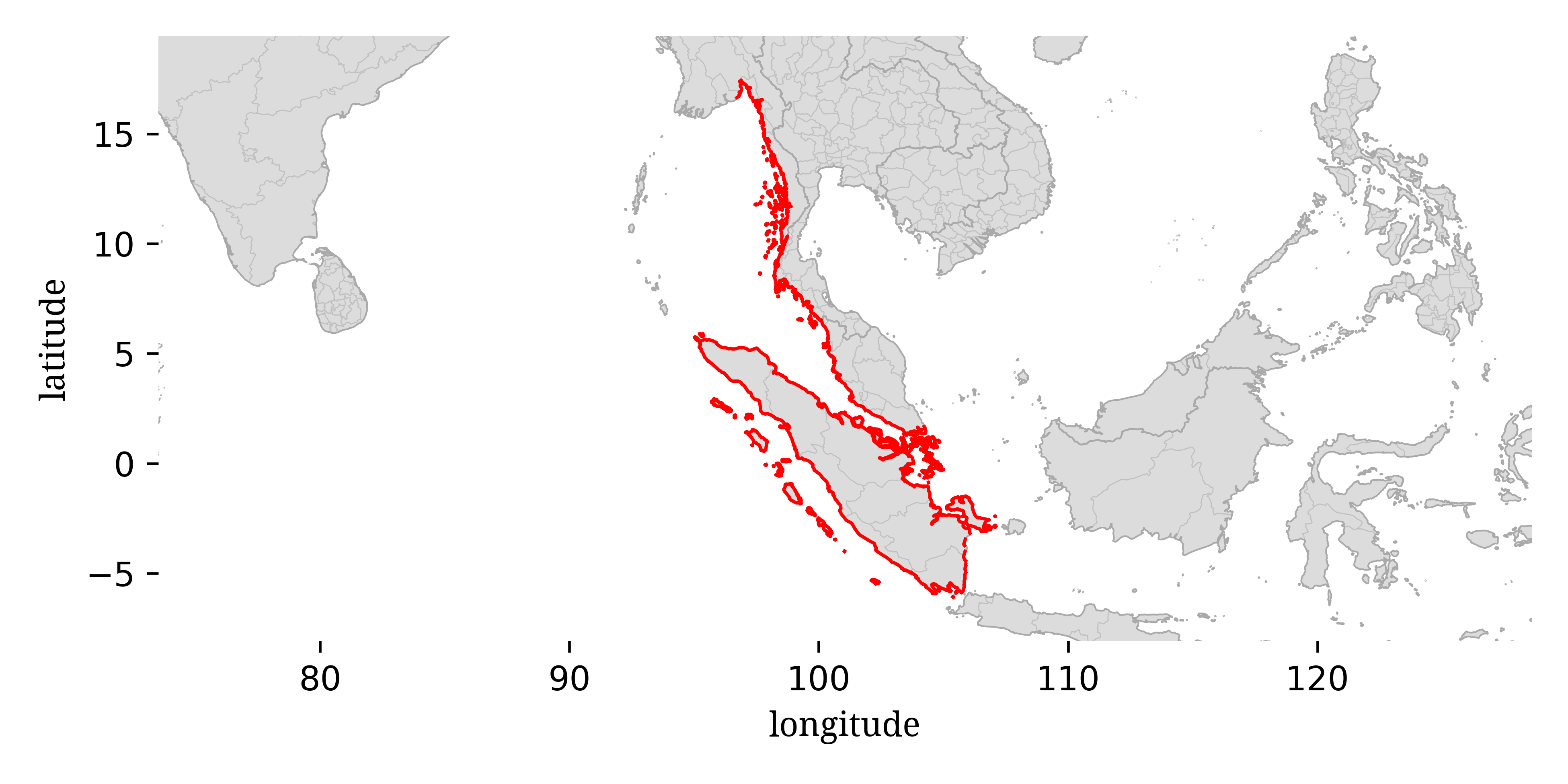
This guide is designed for identification “in the field” where you might be looking at live crabs by eye or through binoculars or from photographs. I will generally try to avoid characters that will require you to physically catch the crab, although I may mention a few for secondary verification. It does not include the more strict taxonomist-style characters that may only be visible under a microscope or via dissection. It is also assumed that the individuals are living, as death (and even capture) can cause dramatic color change.

This is a guide to the fiddler crabs of the western Malay Peninsula, including southeastern Myanmar, and the west coasts of Thailand and peninsular Malaysia (excluding Johor). This region represents a complicated transition between the eastern Indian Ocean and the western Pacific Ocean faunal assemblages. There are at least 9 species present:
I currently view two others that have been reported in the literature, Austruca perplexa and Tubuca dussumieri, as somewhat suspect for the region and am not including them in this guide for now.
A number of features can be used to distinguish among these species, but a good place to start is to look at the distance between the base of the eyestalks. Fiddler crabs tend to split into two groups, those with the eyestalks very close together (“narrow front”) and those with the eyestalks separated a bit more (“broad front”). Two of these species (Austruca annulipes and Austruca bengali) are broad front species, while the others (Gelasimus hesperiae, Gelasimus tetragonon, Gelasimus vocans, Tubuca alcocki, Tubuca forcipata, Tubuca paradussumieri, and Tubuca rosea) are narrow front species. Note that the carapace between the eyestalks appears pinched together in the narrow front species, but more trapezoidal in the broad front species.
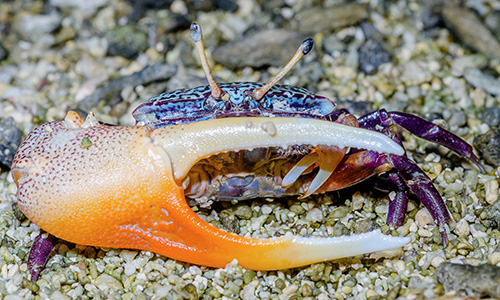
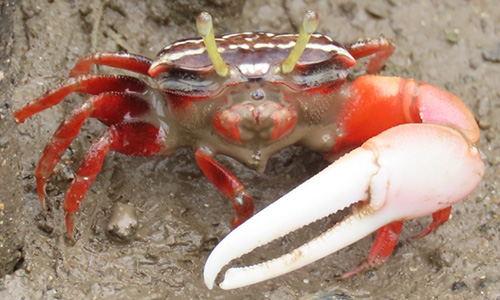
Austruca annulipes is a common, wide-spread species. Generally, the carapace of Austruca annulipes tends to be a mix of black and white. The large arm of Austruca annulipes is generally orange or red, with some of the color frequently found on the hand of the claw as well.
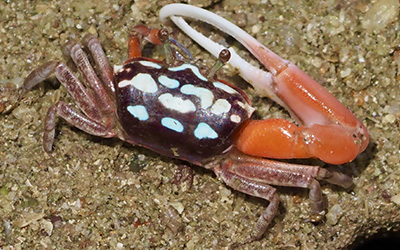
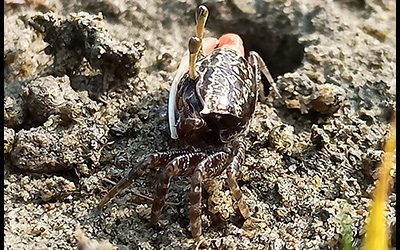
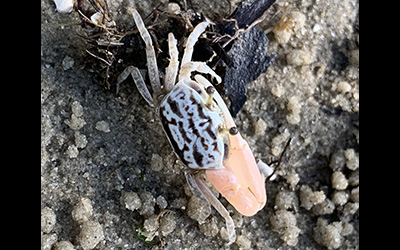
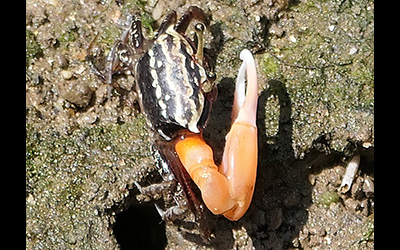
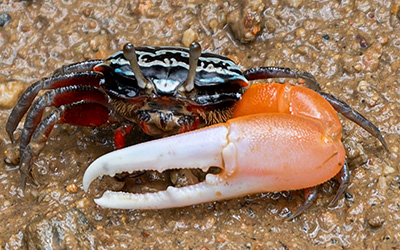
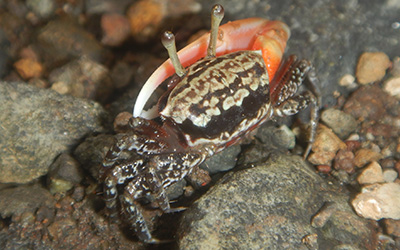
Austruca perplexa has been reported from this region, although current evidence does not appear particularly strong. In general it looks a lot like Austruca annulipes but with more yellow and less red, and a bit more tendency for distinct striping on the carapace. It could be rare or reported observations due to confusion with other species.
A fairly small species, Austruca bengali is easy to identify by color, as it almost always includes bright yellow. Its carapace is tends to be either blue or white with black stripes, although solid yellow or white is not uncommon. Its large claw is almost always solid yellow. Some females may be essentially solid white.
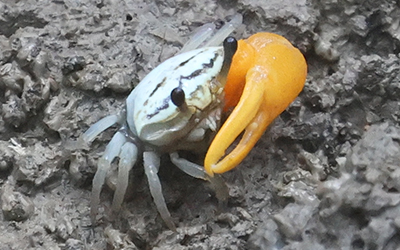
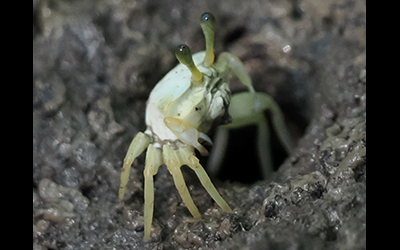

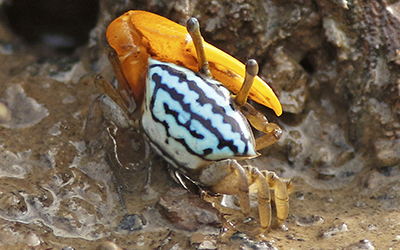
In addition to color, Austruca bengali has a distinctive carapace shape when seen from above. The front corners of the carapace are particularly pointed and the sides of the carapace slope inward at a much sharper angle than most of the other species found in the same area. Tubuca rosea has a somewhat simlar shaped carapace, but is a narrow front species and very different colors.
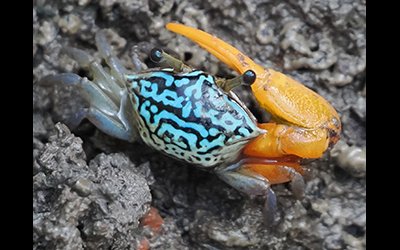
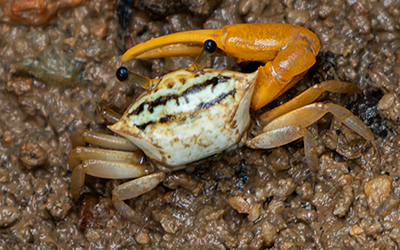
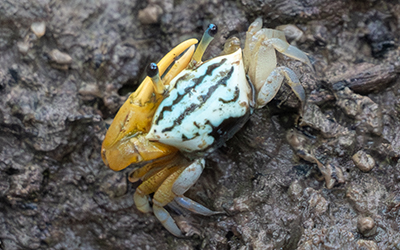
Gelasimus tetragonon is a wide-spread species that is something of an oceanic island specialist, although it is occasionally found on continental shores. It usually has a predominantly blue and black carapace with bright red legs (which occasionally may be darker) and gray eyestalks. The large claw of Gelasimus tetragonon is usually orange, with a noticeably darker red spot near the base of the pollex, and a white dactyl. Gelasimus tetragonon frequently has brown spots on the top part of the hand of the claw.
Gelasimus tetragonon has a lot of additional variability. In some places the carapace can lighten so that there is almost no blue, just a cream or pale orange with black markings. The pattern of the colors on the carapace can vary from stripes or blotches to tiny spots.
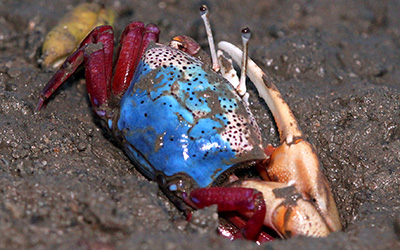
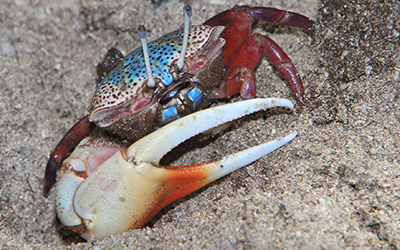
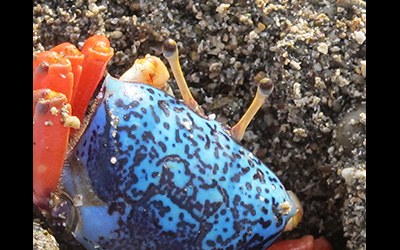
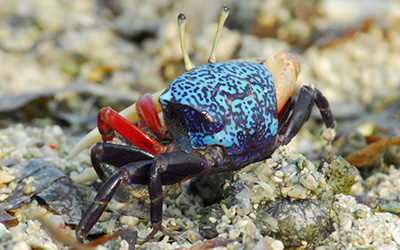
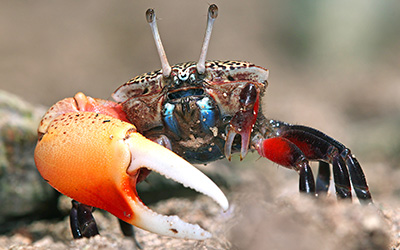
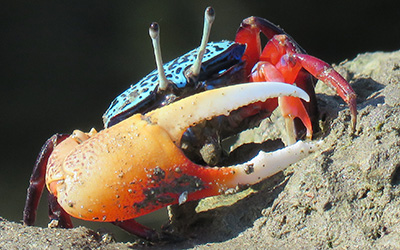
Tubuca rosea tends to be one of the more distinctively colored species. Its carapace is generally semi-translucent, frequently a pale blue or rose red (or both). Its limbs and large claw are generally rose red, with the fingers of the claw a bit paler.
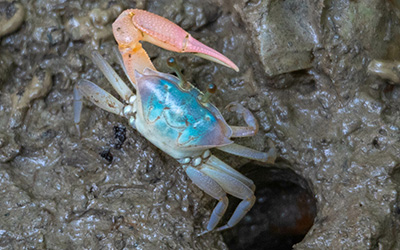
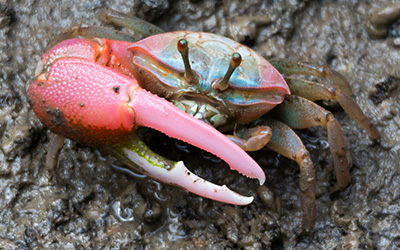

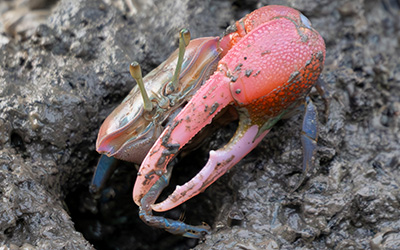
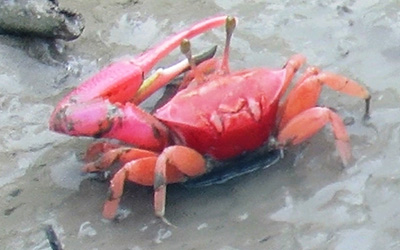
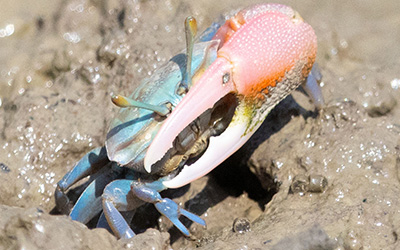
Tubuca forcipata is one of the more variable and confusing species, with multiple color forms that are not particularly similar to each other. One expert on fiddler crabs from the region has suggested that the name currently encompasses multiple, undescribed species being mixed together, but the formal work to determine if this is true and disentangle the various forms has not been completed at this time.
What I would refer to as the canonical form of Tubuca forcipata is a fiddler crab with a dark carapace with pale speckling (either white or pale blue) and a large claw where all or most of the hand is dark purple with the rest of the claw white. The claw is frequently heavily toothed and the tips of the fingers of the large claw often appear to come together as forceps, giving the species its name.
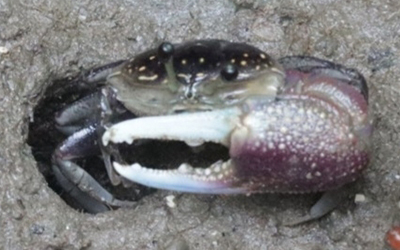
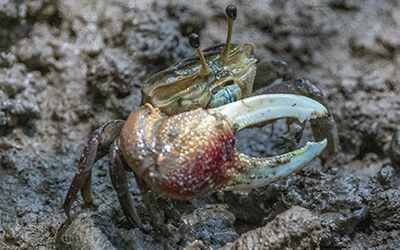
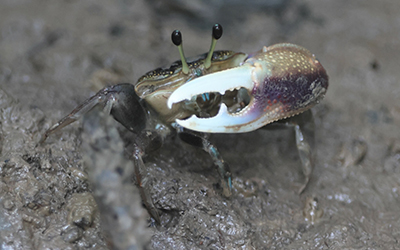
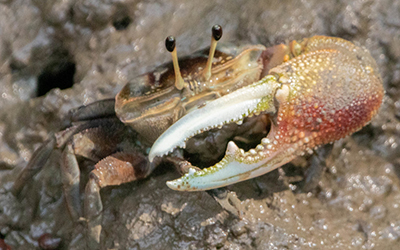
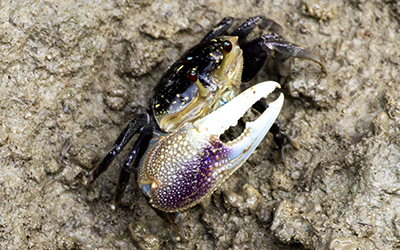
The second color form of Tubuca forcipata is completely different, with the crab a mix of black and bright red, generally with the black on the back half of the body and red on the front half, including the entire claw. The literature suggests that this bright red form is common in juveniles or yournger crabs of this species.
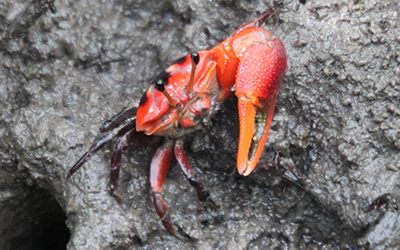
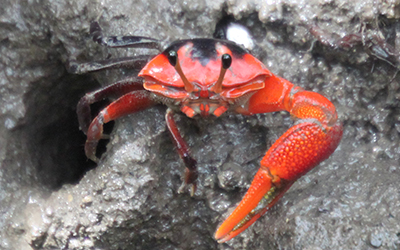
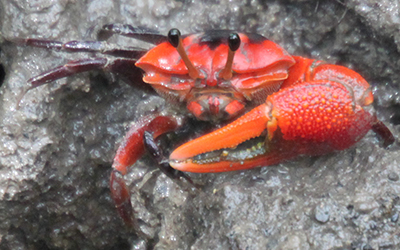
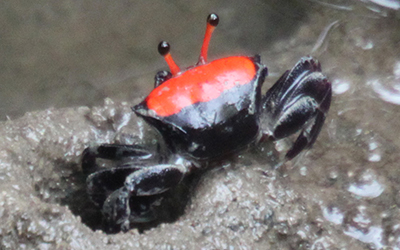
A third color form of Tubuca forcipata is vaguely in between the previous two, although not particularly similar to either of them. In this form, the carapace is generally black with large tan/beige patches toward the front, the legs are frequently pale gray, and the large claw has a dark red hand with orange fingers.
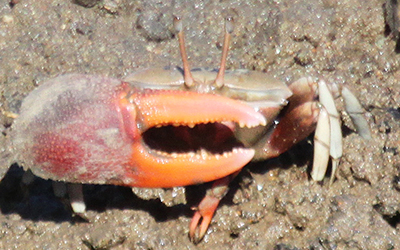

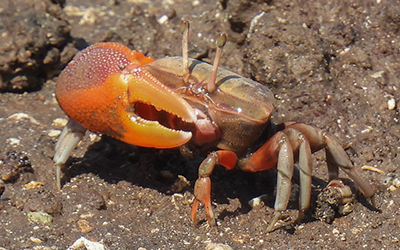
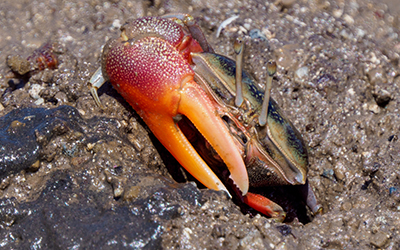
Are these all the same species? Maybe. It could simply be a variable species, the differences might represent age or developmental stage or regional variation. There are some additional patterns beyond color that separate these forms, particularly the first and third. The claw on the first form is notably toothier than the other two. The first and third form appear to have no geographic overlap, with the third form only appearing in the southeastern part of the Malay Archipelago (starting from Bali and including various islands further to the east and south), while the first form is only found further north and west (Borneo, Sumatra, etc.). Conversely, the black and red form (which has been suggested as representing a juvenile stage) overlaps with both of the other two in space, at least in part, as it has been seen from Bali (although not necessarily further south or east) to Singapore and the Malay peninsula.
Tubuca alcocki and Tubuca paradussumieri appear to be extremely difficult to distinguish in the field. While there are some notable differences between the species, the characters are extremly difficult to pick up in photographs (specific differences will be described further below). Adult Tubuca alcocki tend to have solid colored, dull, dark blue or brown carapaces, with a large claw with pale, off-white fingers, and a darker hand in dull brown or orange. Males frequently (although not universally) will have a dark orange patch near the base of the lower finger on the large claw.
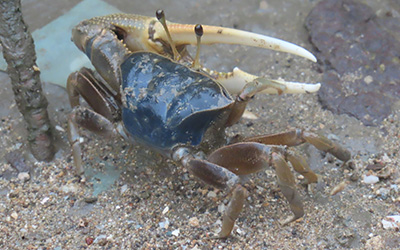
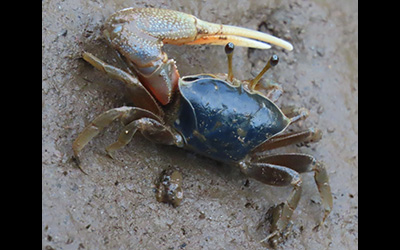
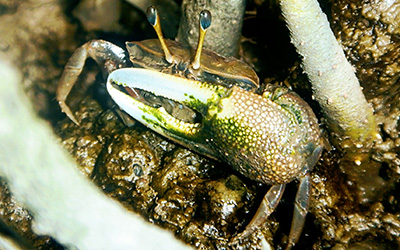

Younger and smaller Tubuca alcocki tend to be much more brightly colored. Their carapace may be more molted, rather than a single solid color, with bright blues, blacks, and some white mixed together. The colors on the large claw are also frequently brighter in color than those on the largest adults.
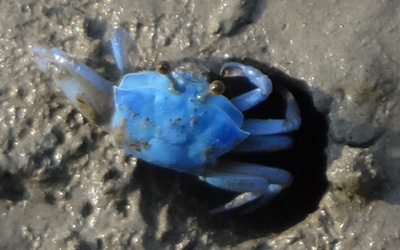

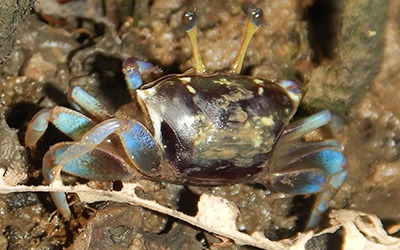
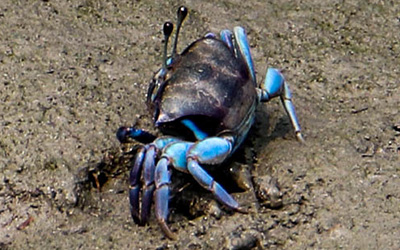
The fingers of the large claw tend to be much straighter and less curved than in the other species, frequently with noticable grooves along them. In the largest individuals, the fingers may be extremely long relative to the size of the hand.
Tubuca paradussumieri is extremely similar to Tubuca alcocki and may be extremely difficult to distinguish. In one common form, adults are generally a rather dull color, with a faded blue-tan carapace (sometimes light, sometimes dark) and generally yellow-tan major claw. Male Tubuca paradussumieri appears to lack the darker orange patch at the base of the lower finger of the large claw that is commonly found in Tubuca alcocki.
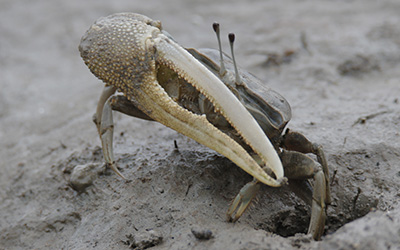
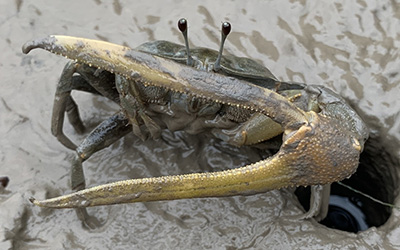
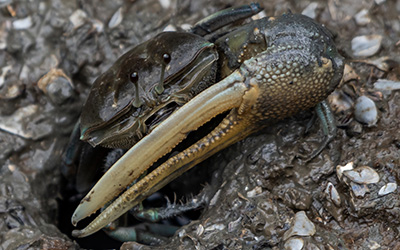
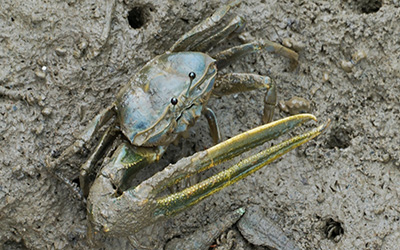
Like with Tubuca alcocki, younger individuals of Tubuca paradussumieri can be a brilliant cobalt blue, with much more typical-shaped claws lacking the overly long fingers.
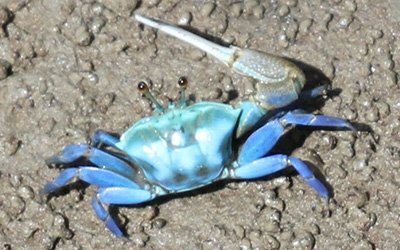
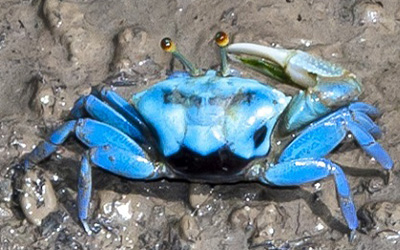
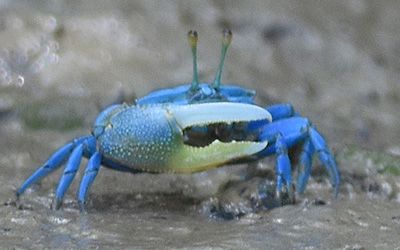
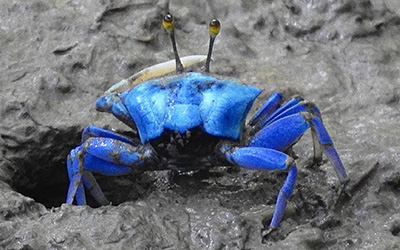
How can we tell these species apart? In terms of color, larger Tubuca alcocki tend to retain dark blue carapaces, while Tubuca paradussumieri often fade to a dark brown; younger individuals of both species are frequently blue. The dark orange patch at the base of the lower finger on the large claw appears to only occur in Tubuca alcocki, although some males appear to lack this spot.
With respecct to general claw shape, large Tubuca paradussumieri appear much more likely to have extremly long fingers than Tubuca alcocki; these overly long fingers are rare in the latter species.
The single absolutely key character that can separate these two species is the number of grooves that run the length of the dactyl (upper finger) on the large claw in males. Tubuca paradussumieri has two grooves, Tubuca alcocki only has one. Unfortunately these grooves can be very difficult to pick out in photos, in part because the pale color of the fingers frequently washes out the subtlely of the grooving.

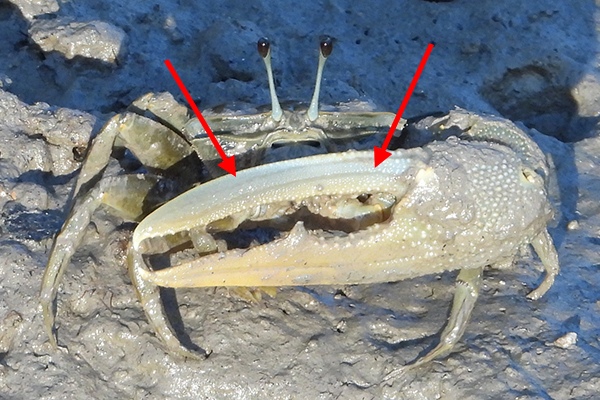
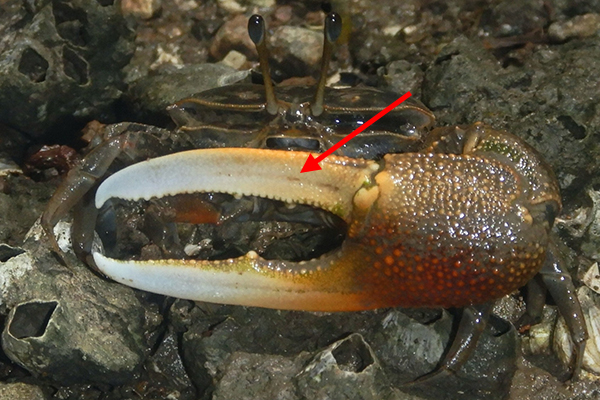
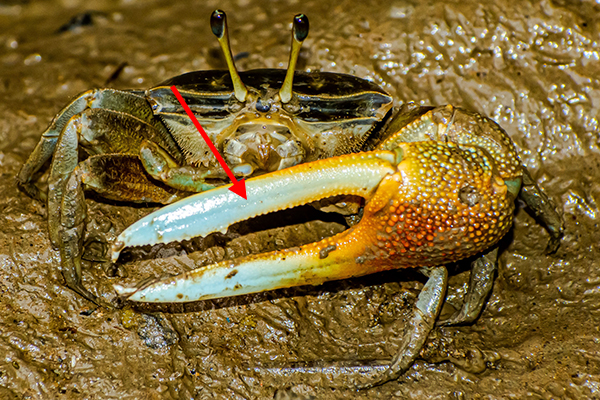
A final subtle between the species is in carapace shape, specifically the front corners of the carapace (generally referred to as the antero-lateral angles). In Tubuca alcocki the front of the carapace curves into this corner forming a moderaly distinct and sharp looking point, followed by a smooth curve along the side of the carapace which begins to rapidly converge as it moves toward the back. In Tubuca paradussumieri, the margins of these corners are more squared and less curved, the corner is broader and less pointy, and is more likely to point a bit to the side rather than forward.
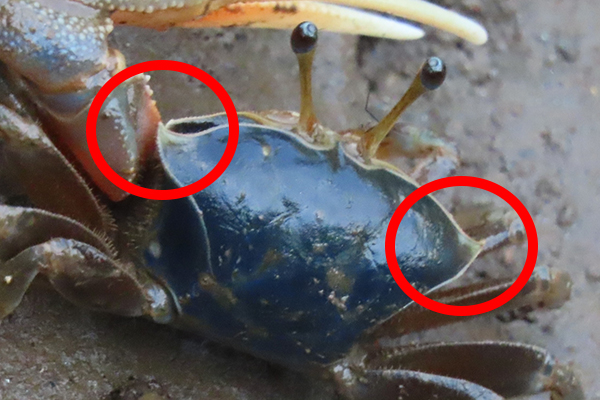
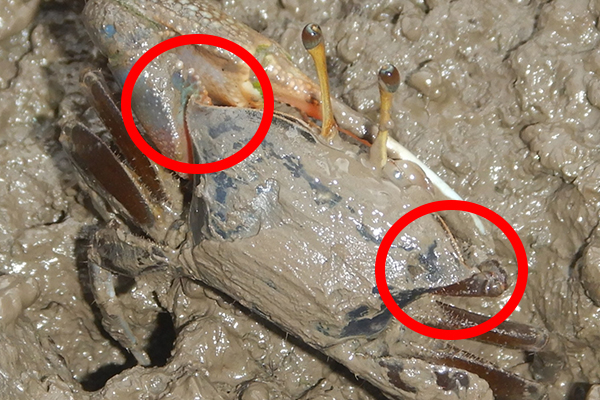
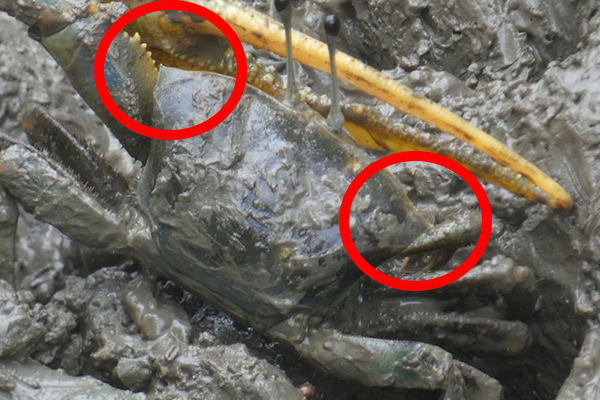

Two species from the subgenus Gelasimus (Gelasimus) are present in this region, but they are all but indistinguishable in the field. Gelasimus hesperiae is likely the only one of the two found in the very northern part of the area, while Gelasimus vocans is likely the only one found found in the very southern part of the area, but to what degree they overlap is unclear. Both species are definitely present in Thailand, but Gelasimus hesperiae may be extremely rare in Malaysia, if present at all (there are some old reports in the literature that it might be found as far south as Singapore). There are a few subtle characters that might possibly help to distinguish them, but not only are they frequently difficult to see, none may be universal or entirely reliable.
Gelasimus hesperiae has a white or pale greenish-brown carapace and a distinctively shaped large claw. The dactyl (upper finger) on the large claw is usually white or pink, while the rest of the claw usually ranges from orange to pale yellow. The dactyl is relatively thick and straight for about half its length before clearly curving to a thick point. The pollex (lower finger) will frequently have two very clear large teeth, one about midway along the length and one near the tip, although one or both can be absent. Like Tubuca alcocki, it has large bumps (tubercles) on the hand of the claw and will often have a noticeable groove along the base of the pollex.
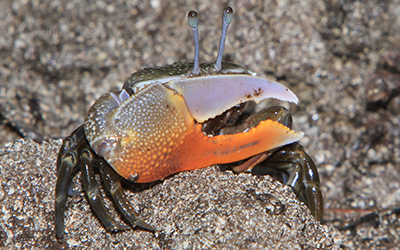
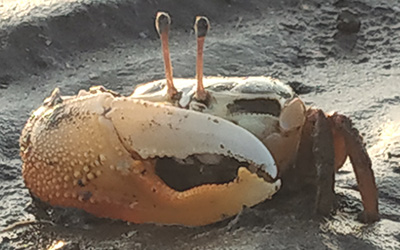
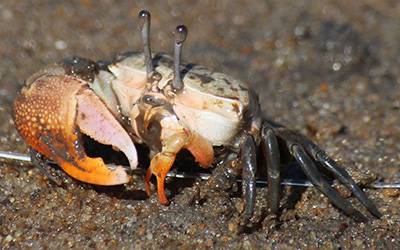
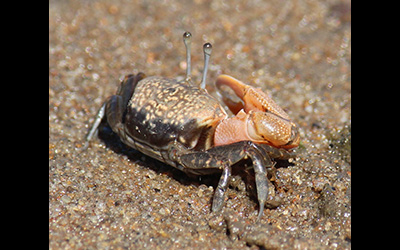
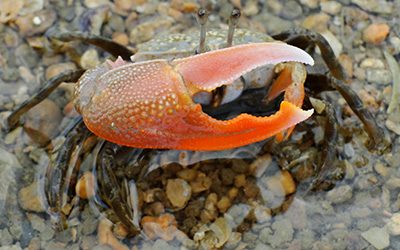
Gelasimus vocans is extremely similar to Gelasimus hesperiae and all but indistinguish in the field. The colors and claw shape are more or less identical.

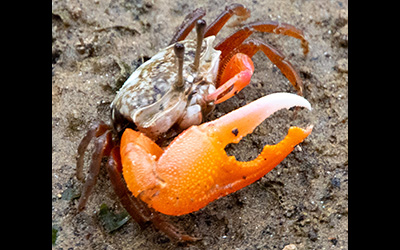

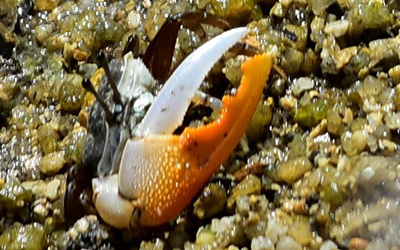
Having stared at lots of photos of both species (taken from areas where they do not overlap), it seems that in Gelasimus hesperiae the dactyl (the upper finger) of the large claw tends to be a bit thicker, particularly where it attaches to the hand, than that of Gelasimus vocans where the dactyl is frequently slimmer. This different is subtle and while there are very few, if any, photos of Gelasimus hesperiae with a particularly thin dactyl, some Gelasimus vocans appear to have a slightly thicker one.
According to the litrature, one very subtle difference which is difficult to see in the field and most photos is in the shape of the small claw on males (and both claws of females). In Gelasimus vocans the gap between the fingers of the small claw tends to be as wide, while on Gelasimus hesperiae this gap is supposedly narrow. I am not entirely convinced that Gelasimus hesperiae consistently has a narrow gap, but it could also be that it is all but impossible to estimate unless the small claw is completely closed, which is rather rare in photographs where you can even see the small claw. Compare the gap in the small claws between these two sets of photos.
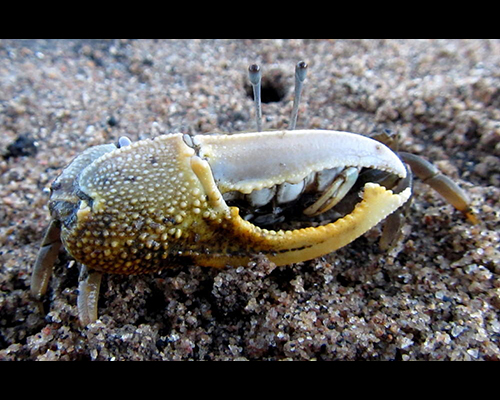
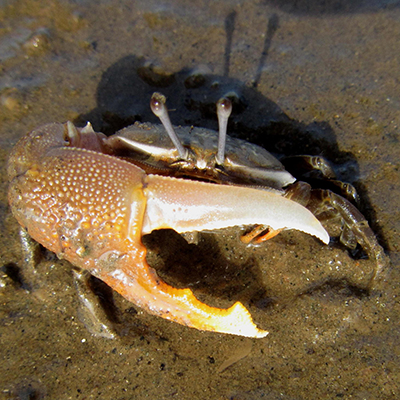
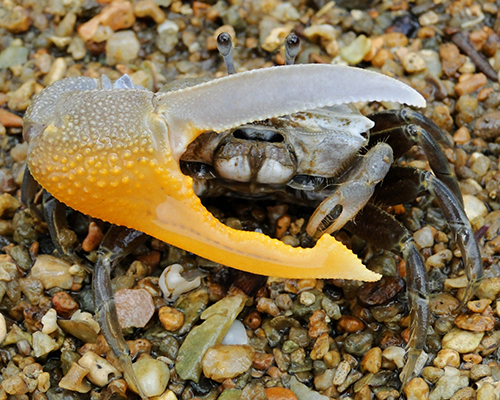
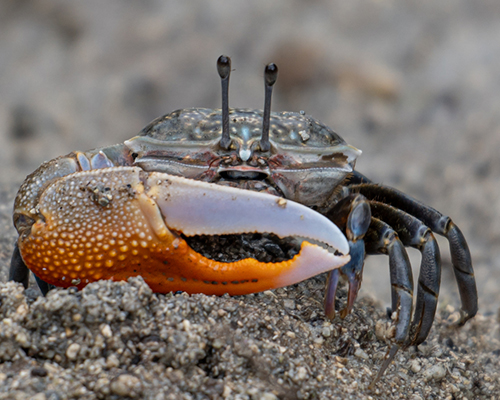
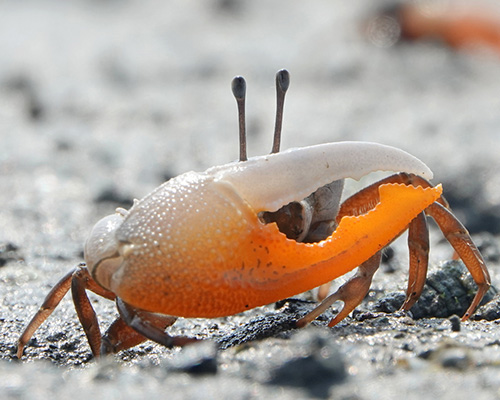
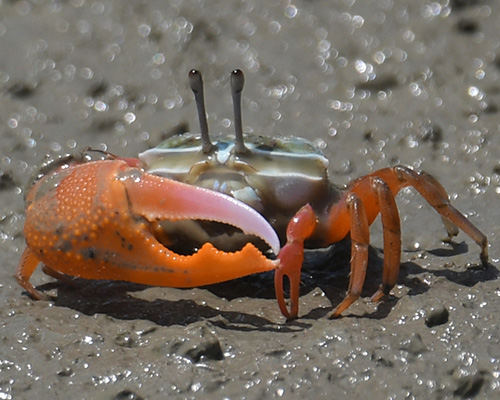
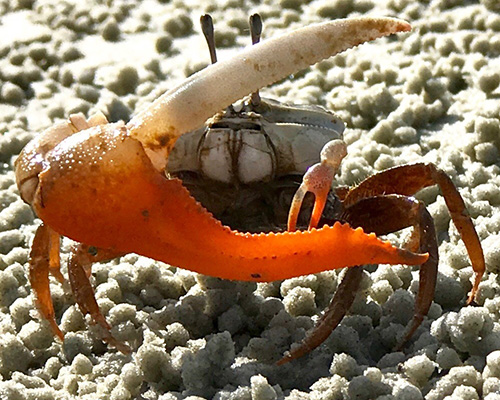
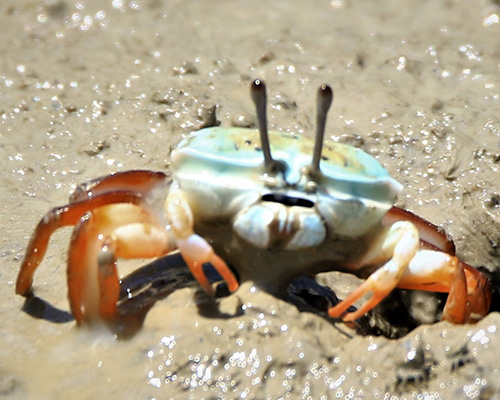
The only other difference I could identify that might distinguish the species without aid of a microscope is a very subtle difference in the shape of the carapace where it extrudes between the eyes. This part of the carapace is known as the front, and the center part of it includes an indented section that sits between the thicker lip that makes up the edges of the front.
In the rare cases where you can see this part of the carapace clearly in a photograph, the shape of the groove in Gelasimus hesperiae has a tendency to be strongly v-shaped, coming to a point between the eyes; in Gelasimus vocans this same groove is a bit wider and shallower and more rounded at the bottom without the sharper point. Unfortunately, this can be extremely difficult to observe and again, I am not convinced it is entirely reliable.
